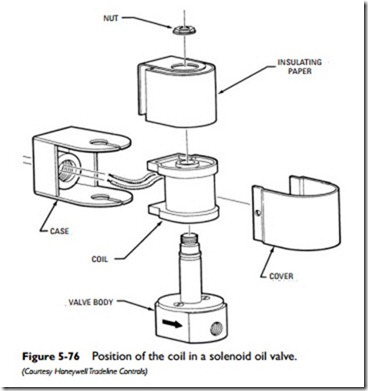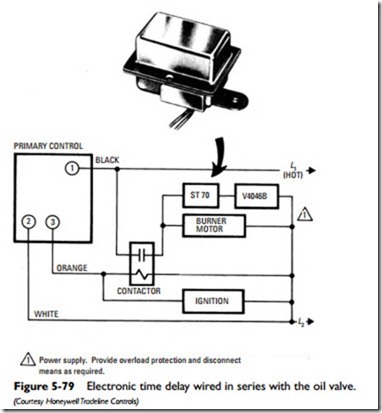Mercury Flame Sensors
Many people frequently confuse mercury flame sensors (MFS) with thermocouples because each has a similar sensor that extends into the pilot flame and a tube connecting the device to the gas valve. Moreover, they have the same function in the control system of a gas-fired appliance, but there are significant differences.
The principal components of a mercury flame sensor (MFS) device are (1) a pilot flame sensor (the portion of the MFS device extending into the pilot flame), (2) a diaphragm/SPDT switch assembly located at the main gas valve, and (3) a hollow capillary tube connecting the flame sensor to the diaphragm/switch assembly.
The operation of a mercury flame sensor device depends on the evaporation of mercury. The sensor end, capillary tube, and the SPDT switch are filled with mercury. When there is enough heat produced by the pilot flame at the sensor end of the capillary tube, it vaporizes and pushes the remaining nonvaporized (liquid) mercury down the capillary tube to the bellows-type diaphragm/switch assembly located at the main gas valve. Movement of the bellows diaphragm presses against a nonadjustable, calculated spring ten- sion with enough force to snap the SPDT switch from one set of contacts to another. This action causes the switch contacts to move from one position to another. In an MFS device switch assembly, the normally closed contact opens and the normally open contact closes. This action deactivates the igniter (after the pilot flame is proven) and opens the main gas valve to allow raw gas to flow to the burners.
Note
Mercury flame sensors are no longer used in gas-fired furnaces and boilers, especially those equipped with solid-state control modules. However, manufacturers still produce replacement MFS units along with their compatible main gas valves.
Oil Controls
The principal functions of the oil controls are (1) to turn the oil burner on and off in response to temperature changes in the space or spaces being heated and (2) to stop the system if an unsafe condition devel- ops. The following controls are necessary to perform these functions:
• Thermostat
• Limit controls
• Primary control
• Oil valves
• Time-delay controls
• Circulator or fan control
• Other auxiliary controls
This chapter is concerned with a description of the oil burner pri- mary control, oil valves, and time-delay controls. The remaining controls found in an oil burner control system are described in Chapter 4 (Thermostats and Humidistats)”and Chapter 6 (Other Automatic Controls).
Oil Valves
Oil valves are used to provide on-off control of the flow of oil to the oil burner. These are normally closed solenoid valves that open when energized and close immediately when deenergized. They are variously referred to as solenoid oil valves, magnetic oil valves, or oil burner valves and are available in either immediate-discharge or delayed-discharge models.
An immediate-discharge oil valve discharges oil as soon as it is energized. A delayed-discharge valve is equipped with an integral thermistor to delay the valve opening for about 3 to 15 seconds (the length of time will vary depending on the manufacturer). This delay allows the burner fan to reach operating speed and establish sufficient draft before the oil is discharged.
A solenoid oil valve will make an audible click when it is opening and closing properly. If the valve fails to open after the room thermostat calls for heat, the following conditions may be responsible:
• Inadequate fuel pressure available at the valve
• An obstructed bleed line
• No voltage indicated at valve
Check the voltage at the coil lead terminals against the voltage shown in the nameplate. Also check the inlet pressure against the rating on the nameplate. If none of these conditions is causing the problem, the failure of the valve to open is probably due to a mal- functioning solenoid coil. The position of the coil is shown in the exploded view of the valve in Figure 5-76. The steps for replacing the solenoid are as follows:
1. Remove the nut on top of the valve by turning it counter- clockwise.
2. Remove the powerhead assembly from the spindle.
3. Disconnect and remove the solenoid coil.
4. Connect the replacement coil and reassemble.
Examples of delayed-discharge valves are shown in Figures 5-77 and 5-78. In both valves, the timing delay is governed by a thermistor attached to the solenoid coil. In these valves, the timing delay will vary with ambient temperature, voltage level, and other factors during normal operation. If the timing is significantly off, it may be nec- essary to replace the thermistor. Because the
thermistor is attached to the solenoid coil, the coil must also be replaced in order to replace the thermistor.
Delayed valve opening can also be obtained by using an electronic time delay wired in series with the oil valve (see Figure 5-79). Unlike the thermistor, the timing of this device is not affected by ambient tem- perature. On a call for heat, the valve open- ing is delayed for approximately 5 seconds.
Oil Burner Primary Control
The oil burner primary control is an auto- matic safety device designed to turn off the oil burner motor should ignition or flame failure occur.
Each primary control operates in con- junction with a sensor by which the burner flame is monitored throughout the burner on cycle. The method used to sense the
burner flame determines the type of primary control used and its location in the heating system.
The two types of primary controls commonly used in oil burner control systems are (1) the cadmium cell primary control and (2) the stack detector primary control. The cadmium cell primary control is burner mounted and uses a light-sensitive cad cell flame detector (sen- sor). The stack detector primary control relies on a thermal sensor to detect flame or ignition failure. This type of primary control assembly is available with the thermal sensor mounted in the stack and the
primary control mounted on the burner, or with both the primary control and thermal sensor mounted in the stack as a single unit.


